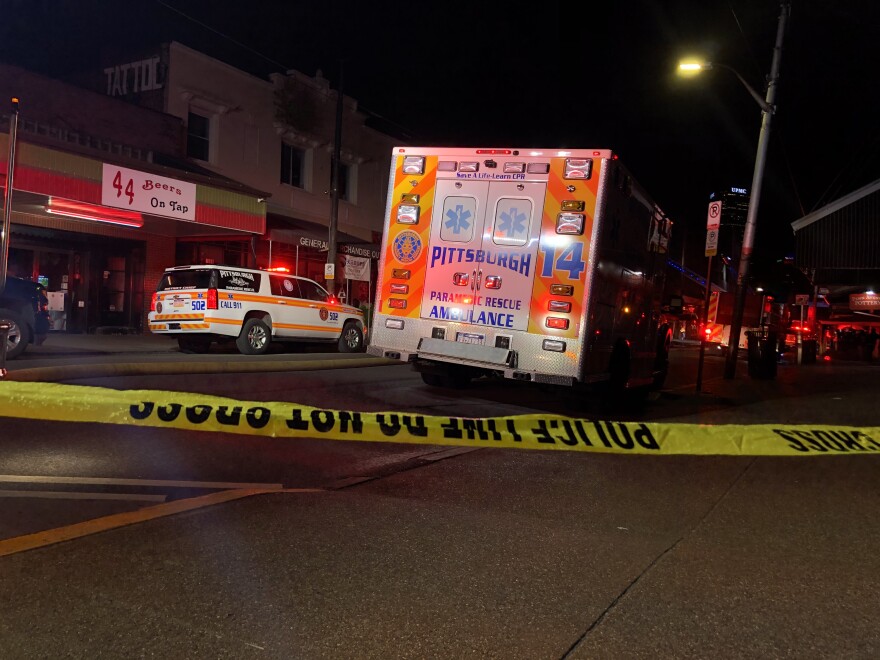While Pittsburgh leaders have been preoccupied with questions about whether the city has enough police officers, the City Controller’s office is sounding the alarm about staffing needs in another public safety bureau: Emergency Medical Services.
In an audit released Wednesday, the office found Pittsburgh EMTs and paramedics are routinely required to work 18-hour shifts. That’s in part due to a staffing shortage that leaves the bureau 7% shy of its budgeted positions, according to the audit. The Controller’s office noted that the shortage reflects a nationwide trend, but recommended more aggressive recruitment campaigns and signing bonuses as solutions.
“The city needs more paramedics,” said Controller Michael Lamb. “Our medics are the best in the region, but they continue to leave and find less stressful work elsewhere.”
In 2021, the Bureau of EMS was $1,046,285 over budget, most of which was due to overtime expenses, according to the audit.
During that same year, nearly all the city’s 16 medical units were in use about 50% of the time in each shift. Auditors argue that workload leaves less time for tasks like restocking medical supplies, servicing the EMS unit and completing paperwork.
The lack of down time, the audit warns "can cause fatigue and burn-out which can lead to poor patient care or outcome."
In addition to fatigue, the staffing shortage could be contributing to slower response times. For several medical emergencies, including strokes and cardiac incidents, the audit found that Pittsburgh EMS was on average more than a minute slower than the standard recommended response rate set by the National Fire Protection Association.
Response times in 2021 for various critical incidents were longer compared to the bureau’s rates in 2012 and 2013. It took at least 30 seconds longer to respond to a reported stroke in 2021 than in 2012 and 2013. The bureau’s response time for cardiac arrests in 2021 was more than two and a half minutes slower than in 2012.
In response to those findings, city EMS officials claimed that cardiac response delays beyond 30 seconds could be attributed to record-keeping errors.
“Cardiac arrest is not the same as chest pains or heart problems … and response times could be different,” the EMS bureau asserted in its written response to the audit.
And Pittsburgh EMS significantly outperformed Pennsylvania and nationwide survival ratings for cardiac incidents. More than 31% of cardiac arrest patients in 2021 made it to the hospital in Pittsburgh, which is nearly 7 percentage points higher than state or national averages.
“This is an impressive accomplishment considering the Bureau staffing issues,” auditors said.
EMTs and paramedics averaged a better response rate for trauma calls and overdose and poisoning incidents. The average response rate for these incidents in 2021 was better than the recommended rate by at least several seconds.
EMS responded to 1,076 reported overdoses in 2021, an average of about three calls per day. The Controller’s office said the statistics reflect the worsening opioid epidemic.
“This was so uncommon in previous EMS audits that it was not reported on. In fact, during a ride-along, auditors witnessed an overdose,” the office said.
The audit found that half of all trauma calls in 2021 were for shootings. Downtown Pittsburgh was the neighborhood with the highest number of total EMS calls: 6,376. Carrick and the South Side Flats were second and third with 3,463 and 3,210 calls respectively.
The city has 13 medic units and three “Basic Life Services” ambulances that service the entire city from 7 a.m. to 11 p.m. with a reduced number of units overnight. BLS ambulances are not equipped with advanced medical equipment and are staffed by EMTs who cannot administer medications or do procedures that break the skin of a patient.
The audit recommends that EMS request more paramedic positions be added to the budget to reduce workloads and overtime expenses. In its response, the bureau agreed with the recommendation and said the bureau wants to staff two more advanced medical units and one BLS ambulance.
In response to concerns about recruiting efforts, the bureau pointed to the city’s current recruitment strategy with the city’s Department of Human Resources, and said it hopes to eventually launch an apprenticeship program to boost recruits.
But the Bureau noted that “these plans would require commitments from the city to increase both the EMS budgetary amounts and personnel staffing levels.”
The audit found the Bureau of EMS has an aging vehicle fleet — a problem it shares with other city departments. The oldest of the Bureau’s 79 vehicles, a trench collapse rescue truck, is 38 years old. Auditors found that 22 EMS vehicles have over 100,000 miles, and seven ambulances rank among the ten EMS vehicles with the highest miles.
Prior to the pandemic, the city replaced three frontline ambulances per year. But that schedule changed as a result of the pandemic and changes in leadership. In 2021, the audit found that no vehicles were replaced. The controller recommended that EMS develop a new fleet replacement strategy to ensure vehicles are being replaced appropriately.
The EMS bureau said it continues to request new vehicles every year “and will continue to do so,” but added that it “has not received vehicle purchase allowance confirmation.”
Replacing public safety and public works vehicles has been a hot topic at the City Council table in the last year. Members have largely focused their efforts on police and fire vehicles, but Lamb argued similar steps need to be taken to replace infrastructure within the EMS bureau.
“I appreciate the ongoing conversation in the City County Building about the City’s fleet," Lamb said "No one is disputing the fact that our EMS vehicles, fire trucks, and police cars are rapidly aging. ... We must invest in the City’s fleet now.”





